Microquasars observation
-
Christian Buil
- Posts: 1431
- Joined: Mon Sep 26, 2011 6:59 pm
- Contact:
Re: Microquasars observation
Thierry Lemoult,
Si tu peux, envoie moi tes profils FITS de Cygnus X-1. Vais essayer de faire un slide pour La Rochelle en fusionnnant avec mes propres observations.
Christian
Si tu peux, envoie moi tes profils FITS de Cygnus X-1. Vais essayer de faire un slide pour La Rochelle en fusionnnant avec mes propres observations.
Christian
-
Olivier Thizy
- Posts: 370
- Joined: Sat Sep 24, 2011 10:52 am
- Location: in the french Alps...
- Contact:
SS 433 observing campaign ?
Hello,
there has been some very interesting discussion on SS 433 and microquasars at La Rochelle Pro/Am meeting. This will certainly become a subject of interest in the time coming for low resolution spectroscopists..
Microquasars, and specially SS 433, are a reduced model of extragalactic huge radio jets which can be seen over several degrees on our sky (Centaurus A...). The issue is those huge jets evolves in hundred of thousands of years... but the astrophysics is assumed to be the same between the big extragalactic one and the "smaller" one such as SS433. The advantage is that the time scale is actually tied to the mass of the object. SS433 time scale is on human scale!
The SS433 system became a system of interest back in 1970's because it was the discovery that
-a supernova remant
-a radio source
-an optical object with very strange spectrum
... were actually tied to the same object... now known as SS433 !
I understood from Katherine Blundell (University of Oxford, UK) that the object is made of:
-a primary star of unknown spectral type
-a secondary companion which is a black hole; the two rotate around their center of mass in about 13 days (first period)
-an accretion disk exists around the black hole; winds eject material from this disk in flows parallel to the polar axis of the disk, both directions. This is visible in the stationary lines (such as the stationnary Halpha line) which is composed actually of 3 lines with one moving back and forth in 13 days as it comes from this disk
-huge jets are coming from the black hole poles (both directions) in very high speed. Material bulbs are ejected every few hours at a speed around 35% of the speed light; they then continue to move toward the ejection direction at the same speed!
-those jets precess like the kayak paddle movement (in an angle close to 40°) in about 163 days (second period); so basically the bulbs are ejected like a canonball making a 40° circle around the sky... and in both direction. They have also a smaller nutation movement visible in the spectra as well
-depending on the line of sight and the canonball direction, the bulb are ejecting toward us or not... then the hydrogen emit a emission line but shifted by Doppler-Fizeau effect... and because the speed is so high, the shift is enormous for a galactic object. Observing window of the Halpha emissions moving around in 163 days is 5800-7800A... be careful with your spectrograph to keep this in mind!
-there is also some material in a ~perpendicular direction from the jet, similar to a ruff around the neck. It is actually not exactly perpendicular and move in a larger angle (~70°) in about 550 days (third period!). This phenomenon is quite unknown and the main goal of Katherine Blundell photometry/spectro project is to better understand this... but it will require several years of observation with phenomenon within hours (with larger telescope and smaller exposure time, 5min phenomena have been observed)
-the material which is around the binary is not impacted by the 13 days binary period and it is visible in the spectrum as two stationary (Halpha) lines around the central moving back and forth line... but those two lines do not move because the material doesn't move...
-some times (about every year), there is an outburst. The stationary lines switches from 3 gaussian to 5. Two additional lines expend to the blue and to the red side of the stationary lines... then the radio outburst is visible. So optical spectroscopy is an "alert" for radiotelescope to catch those outbursts!
While we wait for Katherine Blundell presentation PDF to be shared, you can check out a video she made on a larger subject:
http://royalsociety.org/events/2010/black-holes/
Katherine Blundell showed her project of 4 telescopes around the globe (India, Australia, South Africa, Chile) located in high schools but close to a professional astronomer for support. Those four RCOS 20inch are currently doing photometry and they will do spectroscopy when SS433 is visible.
Amateur with R~1000 spectrograph such as LISA would bring additional data:
-when one of the telescope is down (hardware problem, mousson in India, etc...) to fill in the gaps
-one telescope may detect nothing and the next telescope detect a new line; amateur spectra will help constraining event timing even if resolution is lower than 3000
-in case of outburst, continuous observation will be required to increase observational frequency
...
Two critical points for the spectra:
1/ accurate timing of your observation; double check your PC time and FITS file timing
2/ accurate wavelength calibration as the line position accuracy will be a key factor of success
3/ instrumental response correction
But do not correct your spectra from heliocentric velocity or from telluric lines for exemple; this can be done by batch with a single tool.
Also, an absolute flux calibration would be nice but not mandatory.
In addition to SS433, the goal is to take regular spectra of quieter microquasars (a list will be published soon but Christian Buil is a good start). Some are bright as mag 6 or 9 and regular optical spectroscopy will help detecting burst for them...
Christian web page on microquasars: http://www.astrosurf.com/buil/microquasars/obs.htm
Expectation is that amateur would be able to provide FITS compliant spectra (ie: BeSS format) so they could be incorporated in a pro/am database of microquasars spectra. More to come on this subject this coming summer!
In conclusion:
==>you can already start practicing on SS433 (located in Aquila, so becoming more and more visible!) and follow for exemple the large emission lines that move very quickly!
==>you can also start monitoring other microquasars (such as Cygnus X1), publish your spectra on the forum and archive them in proper FITS/BeSS format so you'll be ready when the database will be ready...
Cordialement,
Olivier Thizy
Vous ne verrez plus des étoiles comme avant !
http://www.shelyak.com/en/
there has been some very interesting discussion on SS 433 and microquasars at La Rochelle Pro/Am meeting. This will certainly become a subject of interest in the time coming for low resolution spectroscopists..
Microquasars, and specially SS 433, are a reduced model of extragalactic huge radio jets which can be seen over several degrees on our sky (Centaurus A...). The issue is those huge jets evolves in hundred of thousands of years... but the astrophysics is assumed to be the same between the big extragalactic one and the "smaller" one such as SS433. The advantage is that the time scale is actually tied to the mass of the object. SS433 time scale is on human scale!
The SS433 system became a system of interest back in 1970's because it was the discovery that
-a supernova remant
-a radio source
-an optical object with very strange spectrum
... were actually tied to the same object... now known as SS433 !
I understood from Katherine Blundell (University of Oxford, UK) that the object is made of:
-a primary star of unknown spectral type
-a secondary companion which is a black hole; the two rotate around their center of mass in about 13 days (first period)
-an accretion disk exists around the black hole; winds eject material from this disk in flows parallel to the polar axis of the disk, both directions. This is visible in the stationary lines (such as the stationnary Halpha line) which is composed actually of 3 lines with one moving back and forth in 13 days as it comes from this disk
-huge jets are coming from the black hole poles (both directions) in very high speed. Material bulbs are ejected every few hours at a speed around 35% of the speed light; they then continue to move toward the ejection direction at the same speed!
-those jets precess like the kayak paddle movement (in an angle close to 40°) in about 163 days (second period); so basically the bulbs are ejected like a canonball making a 40° circle around the sky... and in both direction. They have also a smaller nutation movement visible in the spectra as well
-depending on the line of sight and the canonball direction, the bulb are ejecting toward us or not... then the hydrogen emit a emission line but shifted by Doppler-Fizeau effect... and because the speed is so high, the shift is enormous for a galactic object. Observing window of the Halpha emissions moving around in 163 days is 5800-7800A... be careful with your spectrograph to keep this in mind!
-there is also some material in a ~perpendicular direction from the jet, similar to a ruff around the neck. It is actually not exactly perpendicular and move in a larger angle (~70°) in about 550 days (third period!). This phenomenon is quite unknown and the main goal of Katherine Blundell photometry/spectro project is to better understand this... but it will require several years of observation with phenomenon within hours (with larger telescope and smaller exposure time, 5min phenomena have been observed)
-the material which is around the binary is not impacted by the 13 days binary period and it is visible in the spectrum as two stationary (Halpha) lines around the central moving back and forth line... but those two lines do not move because the material doesn't move...
-some times (about every year), there is an outburst. The stationary lines switches from 3 gaussian to 5. Two additional lines expend to the blue and to the red side of the stationary lines... then the radio outburst is visible. So optical spectroscopy is an "alert" for radiotelescope to catch those outbursts!
While we wait for Katherine Blundell presentation PDF to be shared, you can check out a video she made on a larger subject:
http://royalsociety.org/events/2010/black-holes/
Katherine Blundell showed her project of 4 telescopes around the globe (India, Australia, South Africa, Chile) located in high schools but close to a professional astronomer for support. Those four RCOS 20inch are currently doing photometry and they will do spectroscopy when SS433 is visible.
Amateur with R~1000 spectrograph such as LISA would bring additional data:
-when one of the telescope is down (hardware problem, mousson in India, etc...) to fill in the gaps
-one telescope may detect nothing and the next telescope detect a new line; amateur spectra will help constraining event timing even if resolution is lower than 3000
-in case of outburst, continuous observation will be required to increase observational frequency
...
Two critical points for the spectra:
1/ accurate timing of your observation; double check your PC time and FITS file timing
2/ accurate wavelength calibration as the line position accuracy will be a key factor of success
3/ instrumental response correction
But do not correct your spectra from heliocentric velocity or from telluric lines for exemple; this can be done by batch with a single tool.
Also, an absolute flux calibration would be nice but not mandatory.
In addition to SS433, the goal is to take regular spectra of quieter microquasars (a list will be published soon but Christian Buil is a good start). Some are bright as mag 6 or 9 and regular optical spectroscopy will help detecting burst for them...
Christian web page on microquasars: http://www.astrosurf.com/buil/microquasars/obs.htm
Expectation is that amateur would be able to provide FITS compliant spectra (ie: BeSS format) so they could be incorporated in a pro/am database of microquasars spectra. More to come on this subject this coming summer!
In conclusion:
==>you can already start practicing on SS433 (located in Aquila, so becoming more and more visible!) and follow for exemple the large emission lines that move very quickly!
==>you can also start monitoring other microquasars (such as Cygnus X1), publish your spectra on the forum and archive them in proper FITS/BeSS format so you'll be ready when the database will be ready...
Cordialement,
Olivier Thizy
Vous ne verrez plus des étoiles comme avant !
http://www.shelyak.com/en/
Olivier Thizy
https://observatoire-belle-etoile.blogspot.fr/
https://observatoire-belle-etoile.blogspot.fr/
-
Francois Teyssier
- Posts: 1521
- Joined: Fri Sep 23, 2011 1:01 pm
- Location: Rouen
- Contact:
Re: Microquasars observation
Hi,
Here is the presentation I made in the introduction to the presentation of the microquasar SS443 by Katherine Blundell (University of Oxford, UK)
http://www.astronomie-amateur.fr/Docume ... uasars.pdf
Thank you to observers who contributed whic spectra of SS 443 and Cygnus-X1 : Christian Buil Jim Edlin Thierry Lemoult and Stéphane Charbonel.
SS 443 spectra are welcome. Katherine Blundell will soon provide us a list of targets
François Teyssier
Here is the presentation I made in the introduction to the presentation of the microquasar SS443 by Katherine Blundell (University of Oxford, UK)
http://www.astronomie-amateur.fr/Docume ... uasars.pdf
Thank you to observers who contributed whic spectra of SS 443 and Cygnus-X1 : Christian Buil Jim Edlin Thierry Lemoult and Stéphane Charbonel.
SS 443 spectra are welcome. Katherine Blundell will soon provide us a list of targets
François Teyssier
François Teyssier
http://www.astronomie-amateur.fr
http://www.astronomie-amateur.fr
-
Terry Bohlsen
- Posts: 191
- Joined: Thu Sep 29, 2011 7:40 am
Re: Microquasars observation
I took a spectra of Sco X-1
It was bright enough for me to get a reasonable spectra but is pretty unremarkable. There aren't any lines to identify.

It was bright enough for me to get a reasonable spectra but is pretty unremarkable. There aren't any lines to identify.

Terry Bohlsen
Armidale NSW
Australia
Armidale NSW
Australia
-
Christian Buil
- Posts: 1431
- Joined: Mon Sep 26, 2011 6:59 pm
- Contact:
Re: Microquasars observation
[experiment on SS433 with IR LISA version - i.e. special blazed grating + setting of camera fixing]
Il existe une version "infrarouge" du spectrographe LISA, que je possède. Je l'ai remise en route hier en faveur d'une brève éclaircie sur Toulouse (météo catastrophique )
)
Voici d'abord une séquence d'acquisitions faite pour étalonner l'instrument :
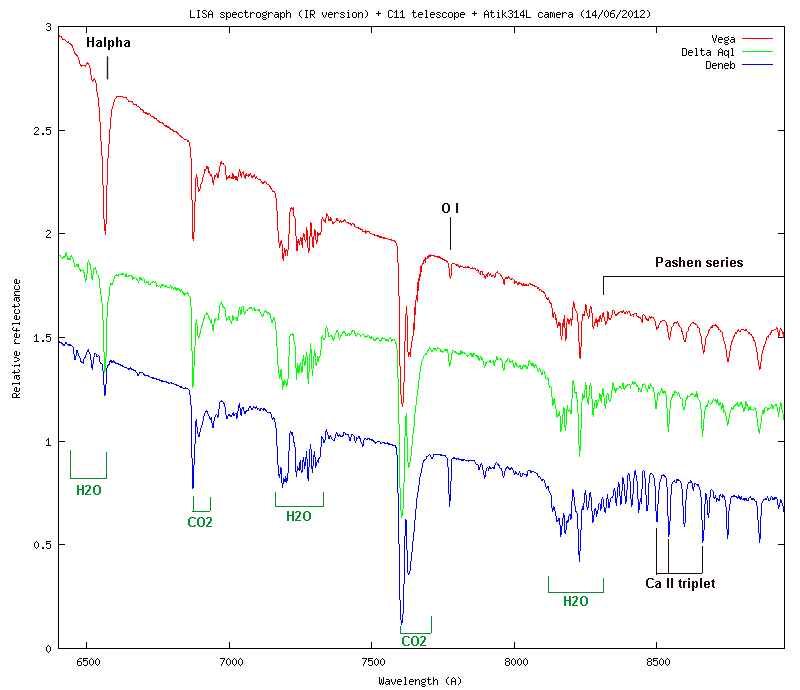
Le spectre dans cette région est très perturbé par de fortes bandes telluriques (l'atmopshère commence a être opaque dans l'infrarouge, dès cette région).
Les raies stellaires sont visible entre ces bandes telluriques. Dans les étoiles chaude le spectre est très dépouillé.
Paradoxalement LISA est plus facile à utiliser dans cette partie du spectre (nombrueuses raies du néon pour étalonner).
J'ai fait une tentative en IR sur SS433, mais la pose est trop courte car interrompue par les nuages et aussi inversion de caméras Atik314L : j'ai monté par erreur un exemplaire très bruité (10,3 électrons de bruit de lecture) au lieu d'un exemplaire très bon (3,9 électrons de bruit)... qui était lui fixé en guidage du LISA. Greeuuu. Ca fait une très grosse différence sur le résultat. Le voici tout de même, sachant qu'il sera possible de faire mieux... :
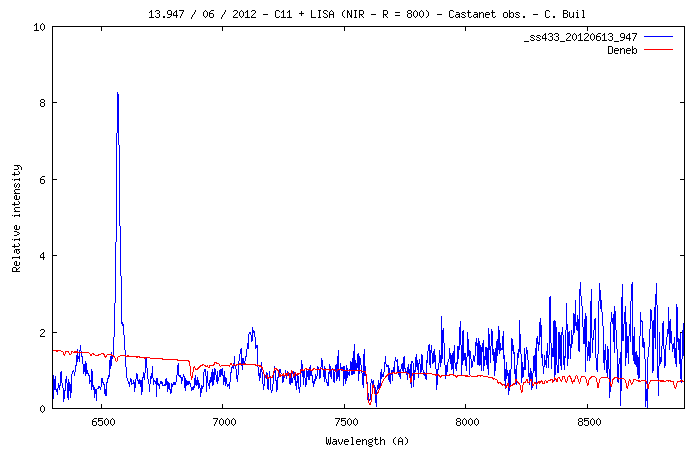
Christian B
Il existe une version "infrarouge" du spectrographe LISA, que je possède. Je l'ai remise en route hier en faveur d'une brève éclaircie sur Toulouse (météo catastrophique
Voici d'abord une séquence d'acquisitions faite pour étalonner l'instrument :

Le spectre dans cette région est très perturbé par de fortes bandes telluriques (l'atmopshère commence a être opaque dans l'infrarouge, dès cette région).
Les raies stellaires sont visible entre ces bandes telluriques. Dans les étoiles chaude le spectre est très dépouillé.
Paradoxalement LISA est plus facile à utiliser dans cette partie du spectre (nombrueuses raies du néon pour étalonner).
J'ai fait une tentative en IR sur SS433, mais la pose est trop courte car interrompue par les nuages et aussi inversion de caméras Atik314L : j'ai monté par erreur un exemplaire très bruité (10,3 électrons de bruit de lecture) au lieu d'un exemplaire très bon (3,9 électrons de bruit)... qui était lui fixé en guidage du LISA. Greeuuu. Ca fait une très grosse différence sur le résultat. Le voici tout de même, sachant qu'il sera possible de faire mieux... :

Christian B
-
Robin Leadbeater
- Posts: 1929
- Joined: Mon Sep 26, 2011 4:41 pm
- Contact:
Re: Microquasars observation
Bonjour Christian
Cheers
Robin
CO2 = 02 ?Christian Buil wrote:[experiment on SS433 with IR LISA version - i.e. special blazed grating + setting of camera fixing]
Le spectre dans cette région est très perturbé par de fortes bandes telluriques (l'atmopshère commence a être opaque dans l'infrarouge, dès cette région).
Pourquoi le bruit est si élevé dans cet exemple? Qu'est-ce que ATIK dire?et aussi inversion de caméras Atik314L : j'ai monté par erreur un exemplaire très bruité (10,3 électrons de bruit de lecture) au lieu d'un exemplaire très bon (3,9 électrons de bruit)...
Cheers
Robin
LHIRES III #29 ATIK314 ALPY 600/200 ATIK428 Star Analyser 100/200 C11 EQ6
http://www.threehillsobservatory.co.uk
http://www.threehillsobservatory.co.uk
-
Christian Buil
- Posts: 1431
- Joined: Mon Sep 26, 2011 6:59 pm
- Contact:
Re: Microquasars observation
A new spectrum of S433 in the NIR with a better camera (less noisy, i.e. 3.8 e-) and a longer exposure time
(but windy conditions):
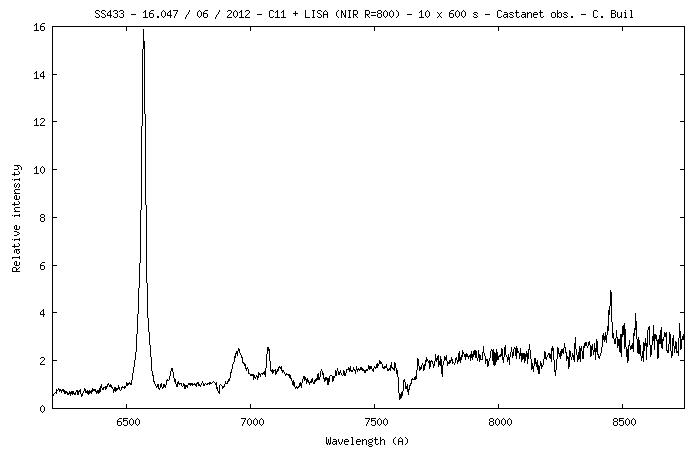
Robin, oups !!! Il faut bien lire O2 au lieu de CO2 (je travaille à l'Agence Spatiale Française,
CNES, sur un projet de satellite visant à mesurer le CO2 de l'atmophère terrestre, dans une partie proche
cette région du spectre, et... j'ai mélanger loisir et travail )
)
Il y a une assez forte dispersion dans le bruit de lecture des caméras Atik (314). Dans l'ensemble,
c'est très correct (4 à 5 électrons de bruit), mais j'ai trouvé des exemplaires plus bruité, dont
un vers 10e-. Et comme le bruit de lecture est un paramètre très important en spectro, cela
a un impact fort sur le résultat.
Christian
(but windy conditions):

Robin, oups !!! Il faut bien lire O2 au lieu de CO2 (je travaille à l'Agence Spatiale Française,
CNES, sur un projet de satellite visant à mesurer le CO2 de l'atmophère terrestre, dans une partie proche
cette région du spectre, et... j'ai mélanger loisir et travail
Il y a une assez forte dispersion dans le bruit de lecture des caméras Atik (314). Dans l'ensemble,
c'est très correct (4 à 5 électrons de bruit), mais j'ai trouvé des exemplaires plus bruité, dont
un vers 10e-. Et comme le bruit de lecture est un paramètre très important en spectro, cela
a un impact fort sur le résultat.
Christian
-
Christian Buil
- Posts: 1431
- Joined: Mon Sep 26, 2011 6:59 pm
- Contact:
Re: Microquasars observation
The 2D spectrum of SS433 before sky removal for 16/06/2012 infrared observation:

Here a negative view (10 x 600 s exposure - LISA IR - C11):

The sky background is dominated by atmospheric OH emission lines.
The folowing spectral profile show the night spectrum of my Castanet-Tolosan observatory. Some OH wavelength
are given (useful for some spectral calibration if necessary):
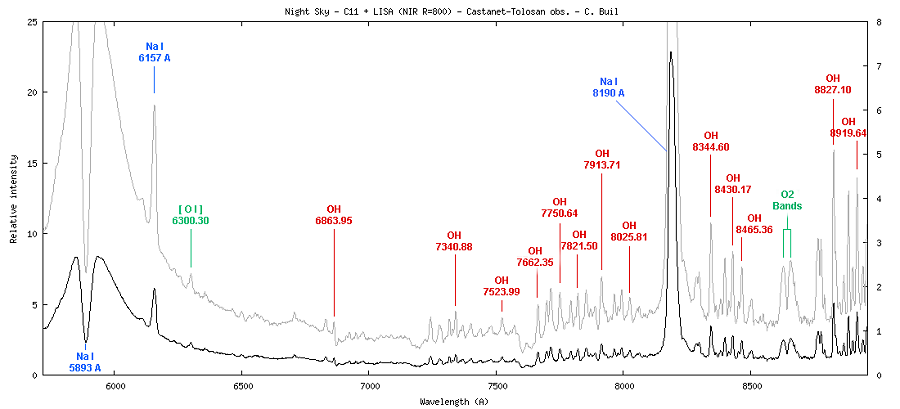
More here: http://www.astrosurf.com/buil/us/spe2/hresol4.htm
Christian

Here a negative view (10 x 600 s exposure - LISA IR - C11):

The sky background is dominated by atmospheric OH emission lines.
The folowing spectral profile show the night spectrum of my Castanet-Tolosan observatory. Some OH wavelength
are given (useful for some spectral calibration if necessary):

More here: http://www.astrosurf.com/buil/us/spe2/hresol4.htm
Christian
-
Olivier GARDE
- Posts: 1244
- Joined: Thu Sep 29, 2011 6:35 am
- Location: Rhône Alpes FRANCE
- Contact:
Re: Microquasars observation
Vendredi soir, j'ai pu faire le spectre de Cygnus X1 au C14 avec mon LISA :
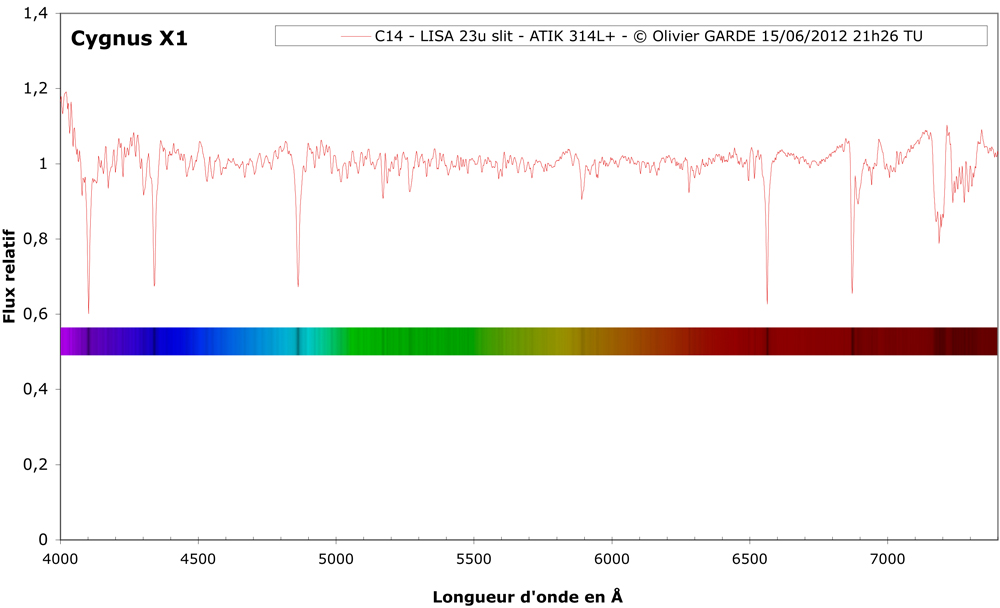
J'ai voulu également faire le spectre de SS433, mais je n'avais pas de chercheur électronique sous la main, et le champ de ma caméra de guidage est trop faible pour bien se repérer.

J'ai voulu également faire le spectre de SS433, mais je n'avais pas de chercheur électronique sous la main, et le champ de ma caméra de guidage est trop faible pour bien se repérer.
LHIRES III #5, LISA, e-Shel, C14, RC400 Astrosib, AP1600
http://o.garde.free.fr/astro/Spectro1/Bienvenue.html
http://o.garde.free.fr/astro/Spectro1/Bienvenue.html
-
Olivier GARDE
- Posts: 1244
- Joined: Thu Sep 29, 2011 6:35 am
- Location: Rhône Alpes FRANCE
- Contact:
Re: Microquasars observation
Voici un spectre du micro quasar SS 433 effectué avec un C14 à f/d7 et un spectro LISA (9 Poses de 600s)
La nuit n'était pas terrible et beaucoup de nuages sont venus perturber les acquisitions.
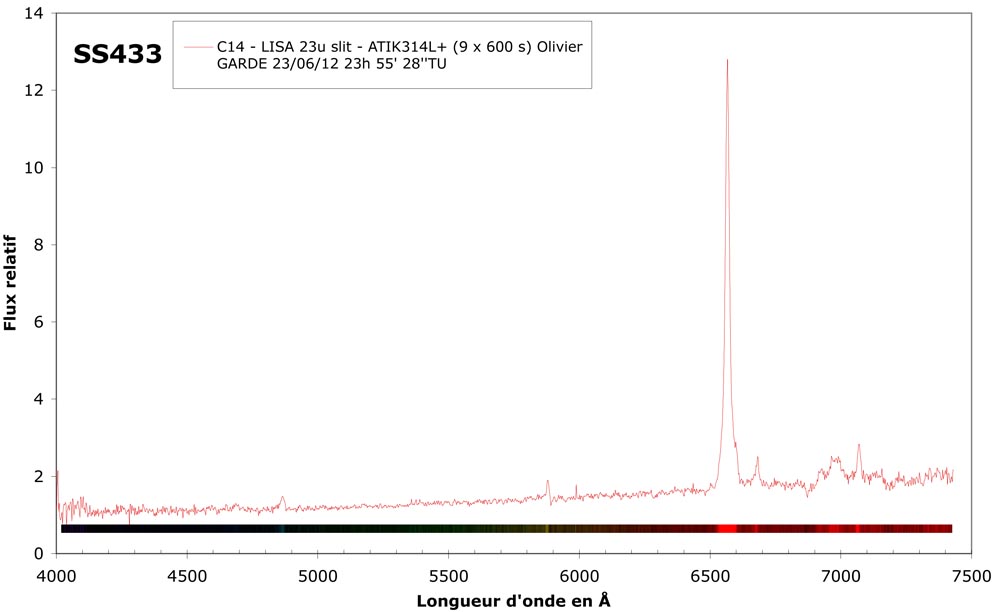
Le problème majeur que je rencontre au niveau de la calibration en flux de mon spectre vient des différences que j'obtiens avec l'étoile de référence (ici Altair) que j'ai fait avant et après les acquisitions sur le micro Quasar.

Comment arriver à bien calibrer son spectre avec ces 2 références bien différentes ?
Olivier GARDE
Here's a spectra of the famous micro quasar ss 433 taken with a C14 and a lisa (9 exposures of 600s).
The night wasn't so good and many clouds have disrupted the 1h30 total exposure on this target.
http://photos.cala.asso.fr/displayimage ... play_media
The main problem I encountered is with the flux calibration of my spectrum : I have take a reference star before and after the main acquisition of SS 433 with Altair, so in a time interval of about 90 minutes.
We can see on the graph somme variation depending on the height of Altair in the sky.
http://photos.cala.asso.fr/displayimage ... play_media
How to make a clean calibration with that ?
Olivier GARDE
La nuit n'était pas terrible et beaucoup de nuages sont venus perturber les acquisitions.

Le problème majeur que je rencontre au niveau de la calibration en flux de mon spectre vient des différences que j'obtiens avec l'étoile de référence (ici Altair) que j'ai fait avant et après les acquisitions sur le micro Quasar.

Comment arriver à bien calibrer son spectre avec ces 2 références bien différentes ?
Olivier GARDE
Here's a spectra of the famous micro quasar ss 433 taken with a C14 and a lisa (9 exposures of 600s).
The night wasn't so good and many clouds have disrupted the 1h30 total exposure on this target.
http://photos.cala.asso.fr/displayimage ... play_media
The main problem I encountered is with the flux calibration of my spectrum : I have take a reference star before and after the main acquisition of SS 433 with Altair, so in a time interval of about 90 minutes.
We can see on the graph somme variation depending on the height of Altair in the sky.
http://photos.cala.asso.fr/displayimage ... play_media
How to make a clean calibration with that ?
Olivier GARDE
LHIRES III #5, LISA, e-Shel, C14, RC400 Astrosib, AP1600
http://o.garde.free.fr/astro/Spectro1/Bienvenue.html
http://o.garde.free.fr/astro/Spectro1/Bienvenue.html